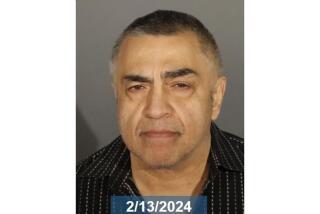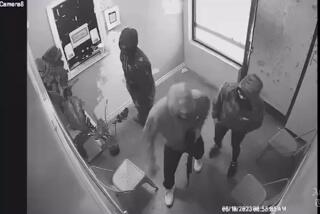Alleged Drug Czar Returned to O.C.
Daniel James Fowlie, the alleged patriarch of a vast drug smuggling operation at a remote ranch in southeastern Orange County, was extradited to the United States from Mexico on Monday, ending a 20-year effort by law enforcement authorities to apprehend him.
Fowlie, wanted on at least 26 drug-related charges filed in federal court, was turned over to U.S. authorities at a Baja California prison in the afternoon and flown to John Wayne Airport aboard a U.S. Customs Service plane.
He set foot back in the United States about 5:40 p.m. at the Martin Aviation terminal--his hands shackled to his waist and under the escort of federal agents.
The man who painted a long-eared horned owl for Mexican President Carlos Salinas de Gortari while in prison was led across the Tarmac to a waiting vehicle that took him to the federal detention center in Los Angeles.
He was dressed only in a yellow tank top, white jeans and shoes. Federal agents said he was totally surprised by the extradition and did not have time to gather personal items from his prison cell. They said Fowlie was under the mistaken impression that he was on the verge of winning his fight to remain in Mexico, where he owns property near Cabo San Lucas.
âWe are very happy,â said Supervising Special Agent Wylie B. Cox of the FBIâs Santa Ana office. âThis brings to resolution a case that we--the FBI, the IRS, Customs Service and the state Department of Justice--have put a lot of time into.â
Fowlie is accused of smuggling hundreds of thousands of pounds of marijuana and lesser amounts of cocaine into the United States from Mexico using rented warehouses in Orange County and Rancho del Rio, a 213-acre spread off Ortega Highway. So far, six people have been convicted, including Fowlieâs two sons.
Federal agents say the property was part of one of the largest marijuana smuggling operations in the country from 1982 to 1985. They further allege that Fowlieâs profits were laundered through a shell company called Tenco International Petroleum Corp. based in South Laguna and the Netherlands.
President Bush used the ranch last spring as a backdrop for a nationally televised address on drug abuse. More than 1,500 prominent citizens, law enforcement officials and local politicians attended the speech.
âFowlieâs name has been with me for the last five years. Itâs a big case.â said Customs Agent Robert M. Mattivi, who investigated Fowlie and escorted him back to the United States. âEveryone realized that there wasnât a snowballâs chance in hell of this happening.â
Fowlie was handed over to U.S. agents during an official proceeding at Centro de Readaptacion Social, a prison on the dusty outskirts of La Paz, where he has been fighting extradition for three years.
A court in Mazatlan, Mexico, which handled Fowlieâs appeals, upheld his extradition to the United States in late June despite his claim that his extradition would violate the Mexican Constitution.
Authorities processed the final paper work for his return last week. It is believed to be the first formal extradition of a prisoner from Baja California to the United States since the 1890s.
Mattivi and FBI Special Agent Stanley Fullerton, who have worked on the Fowlie case for more than five years, said they met with about 20 Mexican officials at the prison Monday afternoon for several hours. During a formal proceeding, they said, Mexican officials heralded Fowlieâs return as a sign of new cooperation between the United States and Mexico in the war on drugs.
Fullerton said that when Fowlie was brought into the wardenâs office, he was surprised and refused to sign any documentation related to the case. On the plane, Mattivi and Fullerton said, Fowlie expressed disbelief that he was being returned to face trial.
âHis only statement was that his lawyer had told him that he had won his extradition fight and that there must have been political pressure on Mexico by the United States,â Mattivi said. âHe kept saying, âI canât believe this is happening.â â
In contesting his extradition, Fowlie maintained that the charges against him not only violated the Mexican Constitution but also were the product of three convicted drug dealers who âmade up storiesâ to save themselves. Among other things, he contended that Mexican law does not allow the use of convicted felons as the basis for criminal charges.
âThey have no tape recordings, no drug buys, no nothing on me,â Fowlie said in an interview with the Times in January. âWhen they do get something on me, itâs always some other criminal, and thatâs what they donât like down here (Mexico). Those guys are three-time losers and full-time liars. They are the worst kind of people.â
Fowlie is scheduled to be arraigned today before U.S. Magistrate Ronald Rose at the federal courthouse in Santa Ana. If convicted on all counts, he could face a maximum penalty of life in prison and a $2-million fine, according to the FBI.
He and his lawyers contend that the charges are greatly exaggerated and that a search of Rancho del Rio in 1985 might have been improper, which could force the suppression of key evidence against him.
Fowlie has spent much of the last three years at Centro de Readaptacion Social and, with the help of an errand boy and friends in Cabo San Lucas, managed to make a living selling art and doing consulting work for a construction business.
The Times reported in March that during his imprisonment, Fowlieâs captors freed him repeatedly to go marlin fishing, visit his beachfront house and work on a shopping center in Cabo San Lucas, a popular haven for American sportsmen.
Sources said Fowlie was often given four-day passes from prison to pursue recreation and personal business in Cabo San Lucas, where he is known to dozens of hoteliers, restaurateurs, lawyers and skippers of sportfishing boats.
His oil paintings of fish and marine fowl also have been shown at art shows in the town, and the bar association of Baja California, Sur, commissioned him to do a painting of a horned owl for President Salinas. Fowlie has photos of the presentation to the president.
Fowlieâs return ends almost 20 years of investigations that have led federal, state and local authorities from Orange County to Central America and Europe in pursuit of him.
Authorities first suspected Fowlie of being involved in drugs in the late 1960s and early 1970s when police said they linked him to the infamous Brotherhood of Eternal Love in Laguna Beach.
The loose-knit organization of about 200 people was founded by Timothy Leary, a Harvard University psychology instructor who espoused the âmind-expandingâ properties of hashish, marijuana and the hallucinogen, LSD.
Fowlie, a former abalone diver and surfer who formed a pioneering contingent of big wave riders in Hawaii during the early 1950s, owned the Leather Gypsy in Laguna Beach at the time. The successful leather goods manufacturer had plants in Mexico and major accounts with such retail mainstays as Sears and J.C. Penney.
Laguna Beach Police Chief Neil Purcell, who investigated the Brotherhood as a detective, said Fowlie was suspected of being part of the organizationâs drug distribution network, which was broken up with the arrests of 46 members in 1972.
Fowlie, who lived in South Laguna, was never arrested. He said he sold the Leather Gypsy in the early 1970s for about $3 million during a recession in the fashion industry and left the United States.
Eventually he said he went to Costa Rica, where he bought farmland, beachfront property that includes a popular surfing spot and a mansion from fugitive financier Robert L. Vesco.
Vesco remains accused of stealing $392 million from mutual fund investors and secretly giving $200,000 to former President Richard M. Nixonâs 1972 reelection campaign in an attempt to obstruct a Securities and Exchange Commission investigation. He is believed to live in Cuba.
Fowlieâs name resurfaced in connection with drug smuggling in 1979 when an informant told state narcotics agents that large shipments were arriving at the ranch. State law enforcement officials indicate that Fowlie was capable of handling 400 pounds of cocaine a month.
J.D. Miles, agent-in-charge of the state Bureau of Narcotics Enforcement office in Orange County, said that as late as 1984, state agents were developing information on Rancho del Rio and Fowlieâs holdings in Costa Rica and Panama. No charges resulted, however.
âPeople kept coming forward to give us tips. But none of them wanted to come forward as a witness, and a lot of their information was old,â Miles said. âWe were pretty much stymied because our target was in Holland, Costa Rica and Mexico, completely out of our realm.â
The FBI, IRS and Customs Service took over the investigation and raided Rancho del Rio in February, 1985, after Orange County sheriffâs deputies arrested a ranch employee at a house in South Laguna.
Two years later, Fowlie was arrested by Mexican authorities in Puerto Escondido, south of Acapulco, and mounted a lengthy extradition fight from prison. Meanwhile, six people associated with him, including his two sons, have been convicted on drug smuggling charges.
Of Fowlieâs return to the United States, Orange County Sheriff Brad Gates said: âI think this shows that no matter where dope dealers go and try to hide weâre going to find them. . . . I think the FBI, the DEA and the INS deserve a lot of credit.â
RANCHO DEL RIO CHRONOLOGY
Daniel James Fowlie is suspected of operating a huge drug-smuggling operation on a 213-acre Orange County ranch. Shipments of marijuana and cocaine from Mexico were reportedly packaged at Rancho del Rio for distributors nationwide. Here are key dates: February, 1985: Orange County sheriffâs deputies arrest Wade T. Westmoreland, an employee of Rancho del Rio, at his home in South Laguna, where authorities allegedly find a bale of marijuana. Items seized lead investigators to the ranch. A police raid uncovers evidence of drug smuggling. July, 1985: Federal authorities using asset seizure laws take control of Rancho del Rio with its 12 structures of imported logs and river rock. Eventually, the spread off Ortega Highway is turned over to Orange County. April, 1987: Mexican authorities arrest Fowlie in Puerto Escondido, a fishing village and popular surfing spot 250 miles south of Acapulco. Fowlie mounts an extradition fight and is transferred to a prison in La Paz, Mexico. November, 1988: Fowlie is indicted on 26 drug-related counts in U.S. District Court. Charges include conspiracy to distribute and sell hundreds of thousands of pounds of marijuana and lesser amounts of cocaine. July, 1989: Fowlieâs sons, Daniel Mack, 31, and Gustave Christian, 29, plead guilty to conspiracy to distribute marijuana. The sons are part of a group of six sentenced to prison in connection with operations at the ranch. November, 1989: U.S. Embassy officials in Mexico City lodge a protest when Fowlie reportedly is not in prison during a routine visit by consular officials. Mexico denies any impropriety. April, 1990: Reacting to news stories, U.S. Justice Department officials renew protests about Fowlieâs releases from prison. Mexican authorities deny any improper releases but vow to make sure Fowlie remains in prison pending the outcome of his extradition fight. June, 1990: A Mazatlan court grants United Statesâ extradition request. July, 1990: Under FBI escort Fowlie is flown from La Paz to John Wayne Airport, where he lands at about 5 p.m. Monday. He now faces trial on 26 drug related counts.
More to Read
Sign up for Essential California
The most important California stories and recommendations in your inbox every morning.
You may occasionally receive promotional content from the Los Angeles Times.











